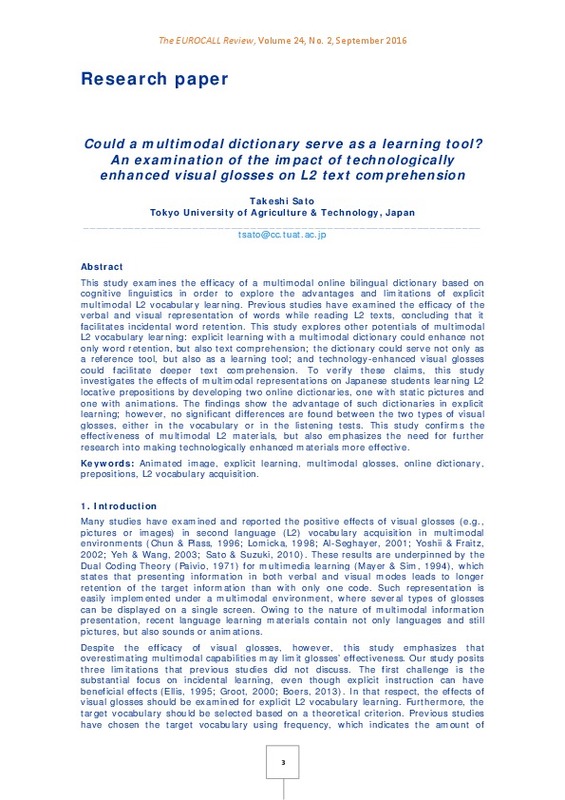Al-Seghayer, K. (2001). The effect of multimedia annotation modes on L2 vocabulary acquisition: A comparative study. Language Learning and Technology, 5(1), 202-232.
Boers, F. (2004). Expanding Learners’ Vocabulary Through Metaphor Awareness: What Expansion, What Learners, What Vocabulary? Cognitive Linguistics, Second Language Acquisition, and Foreign Language Teaching, 211-232. doi:10.1515/9783110199857.211
How cognitive linguistics can foster effective vocabulary teaching. (s. f.). Applications of Cognitive Linguistics [ACL]. doi:10.1515/9783110199161.1.1
[+]
Al-Seghayer, K. (2001). The effect of multimedia annotation modes on L2 vocabulary acquisition: A comparative study. Language Learning and Technology, 5(1), 202-232.
Boers, F. (2004). Expanding Learners’ Vocabulary Through Metaphor Awareness: What Expansion, What Learners, What Vocabulary? Cognitive Linguistics, Second Language Acquisition, and Foreign Language Teaching, 211-232. doi:10.1515/9783110199857.211
How cognitive linguistics can foster effective vocabulary teaching. (s. f.). Applications of Cognitive Linguistics [ACL]. doi:10.1515/9783110199161.1.1
Boers, F. (2011). Cognitive Linguistic approaches to teaching vocabulary: Assessment and integration. Language Teaching, 46(2), 208-224. doi:10.1017/s0261444811000450
Chapelle, C. A. (1998). Multimedia CALL: Lessons to be learned from research on instructed SLA. Language Learning & Technology, 2(1), 22-34.
Cho, K. (2010). Fostering the acquisition of English prepositions by Japanese learners with networks and prototypes. Fostering Language Teaching Efficiency through Cognitive Linguistics. doi:10.1515/9783110245837.257
CHUN, D. M., & PLASS, J. L. (1996). Effects of Multimedia Annotations on Vocabulary Acquisition. The Modern Language Journal, 80(2), 183-198. doi:10.1111/j.1540-4781.1996.tb01159.x
DEWELL, R. B. (1994). Overagain: Image-schema transformations in semantic analysis. Cognitive Linguistics, 5(4), 351-380. doi:10.1515/cogl.1994.5.4.351
Ellis, N. C. (1995). THE PSYCHOLOGY OF FOREIGN LANGUAGE VOCABULARY ACQUISITION: IMPLICATIONS FOR CALL. Computer Assisted Language Learning, 8(2-3), 103-128. doi:10.1080/0958822940080202
Groot, P. (2000). Computer assisted second language vocabulary acquisition. Language Learning and Technology 4(1), 60-81.
Johnson, M. (1987). Body in the mind. Chicago: University of Chicago Press.
Keane, J. A., Nkwenti‐Azeh, B., & Singleton, J. A. (1997). DESIGN CONSIDERATIONS FOR A CALL CONCEPTUAL DICTIONARY. Computer Assisted Language Learning, 10(4), 363-374. doi:10.1080/0958822970100406
Lakoff, G. (1987). Women, Fire, and Dangerous Things. doi:10.7208/chicago/9780226471013.001.0001
Lin, C. & Tseng, Y. (2012). Videos and animations for vocabulary learning: A study on difficult words. TOJET: The Turkish Online Journal of Educational Technology, 11(4), 346-355.
Lindstromberg, S. (1996). English prepositions explained. Amsterdam: Benjamins.
Lindstromberg, S. (2001). Preposition entries in UK monolingual learners’ dictionaries: problems and possible solutions. Applied Linguistics, 22(1), 79-103. doi:10.1093/applin/22.1.79
Littlemore, J. (2009). Applying Cognitive Linguistics to Second Language Learning and Teaching. doi:10.1057/9780230245259
Lomicka, L. L. (1998). "To gloss or not to gloss": An investigation of reading comprehension online. Language Learning & Technology, 1, 41-50.
Mayer, R. E., & Sims, V. K. (1994). For whom is a picture worth a thousand words? Extensions of a dual-coding theory of multimedia learning. Journal of Educational Psychology, 86(3), 389-401. doi:10.1037/0022-0663.86.3.389
Ngu, B. H., & Rethinasamy, S. (2006). Evaluating a CALL software on the learning of English prepositions. Computers & Education, 47(1), 41-55. doi:10.1016/j.compedu.2004.08.016
Morimoto, S., & Loewen, S. (2007). A comparison of the effects of image-schema-based instruction and translation-based instruction on the acquisition of L2 polysemous words. Language Teaching Research, 11(3), 347-372. doi:10.1177/1362168807081181
Pachler, N. (2001). Electronic reference tools for foreign languages: offline vocabulary programs. The Language Learning Journal, 24(1), 24-29. doi:10.1080/09571730185200181
Paivio, A. (1971). Imagery and verbal processes. New York: Holt, Rinehart, and Winston.
Sato, T., & Suzuki, A. (2010). Do multimedia-oriented visual glosses really facilitate EFL vocabulary learning?: A comparison of planar images with three- dimensional images. Asian EFL Journal, 12(4), 160-172.
Sato, T., & Suzuki A. (2011). Verifying Multimedia Gloss: Image schema and polysemous vocabulary in English. Proceedings of the EuroCALL 2011 Conference, 285-293.
Sato, T., Lai Y., & Burden, T. (2014). Examining the impact of individual differences of information processing styles in technology-enhanced second vocabulary learning. Proceedings of CLaSIC 2014, 432-440.
Tanaka, S. (1990). Ninchi imiron [Cognitive Semantics]. Tokyo: San'yusha.
Tanaka, S., Takeda, S., & Kawade, S. (Eds.) (2003). E-gate English-Japanese dictionary. Tokyo: Benesse Corporation.
Yasuda, S. (2010). Learning Phrasal Verbs Through Conceptual Metaphors: A Case of Japanese EFL Learners. TESOL Quarterly, 44(2), 250-273. doi:10.5054/tq.2010.219945
Yeh, Y., & Wang, C. (2003). Effects of multimedia vocabulary annotations and learning styles on vocabulary learning. CALICO Journal, 21(1), 131-144.
Yoshii, M., & Fraitz, J. (2002). Second language incidental vocabulary retention: The effect of text and picture annotation types. CALICO Journal, 20(1), 33-58.
Zwaan, R. A., & Radvansky, G. A. (1998). Situation models in language comprehension and memory. Psychological Bulletin, 123(2), 162-185. doi:10.1037/0033-2909.123.2.162
[-]








